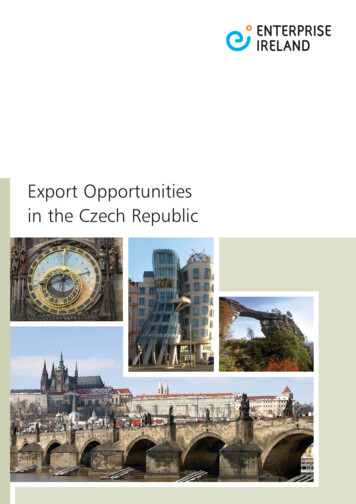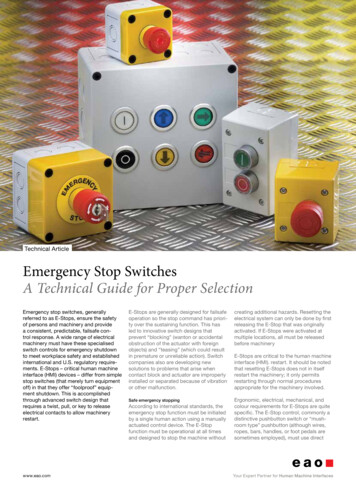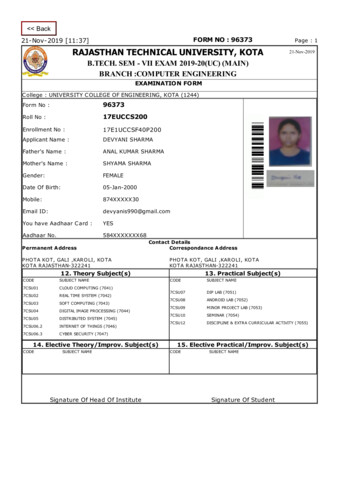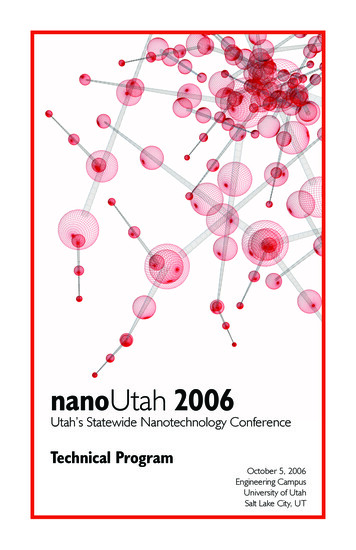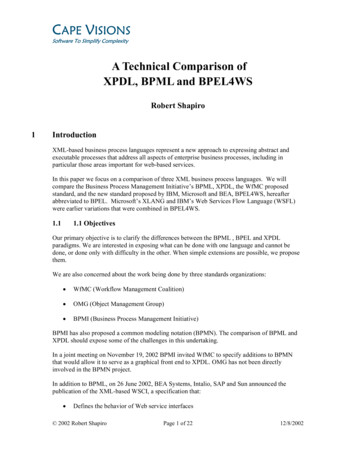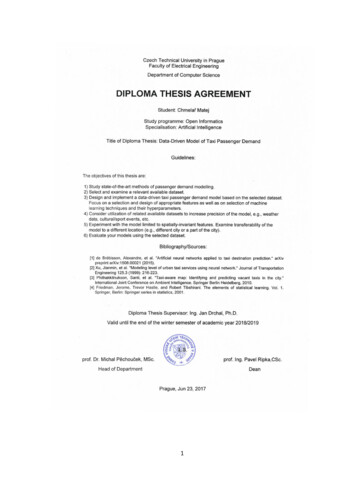
Transcription
1
2
Czech Technical University in PragueFaculty of Electrical EngineeringDepartment of Computer ScienceMaster’s ThesisData-Driven Model of Taxi Passenger DemandBc. Matej ChmelařSupervisor: Ing. Ján Drchal Ph.D.Study Programme: Open InformaticsField of Study: Artificial IntelligenceJanuary 20183
4
i
AcknowledgementsI would like to thank my supervisor, Ing. Ján Drchal Ph.D. for his goodwill,approach, and endless patience. More-over I would like to thank myparents and friends, for their unconditional support during my wholestudy.ii
iii
DeclarationI hereby declare that I have completed this thesis independently and that Ihave listed all the literature and publications used within the research and work. Ihave no objection to usage of this work in compliance with the Act §60 Law No.121/2000Sb. (copyright law), and with the rights connected with the copyright actincluding the changes in the act.In Prague .iv
v
AbstractAbstractThis thesis introduces an overview of methods designed for modelling and prediction of taxidemand, using information available from datasets, consisting mostly of GPS localization, andtimestamps. The objective is to develop a program, which manages to create data-driven model,able to predict passenger taxi demand. This is accomplished by selection of appropriate features,working with selection of data and configuring parameters of said model. Result of this thesis ismodel able to slightly predict the pickup location – latitude and longitude. Experiments show howwell created model works, with comparison between single approaches.Keywords: random forest, regression, machine learning, prediction, data-driven model,passenger, taxi, demandvi
AbstraktAbstraktTáto práca uvádza prehľad metód určených na modelovanie a predikciu taxi dopytu, s využitíminformácii dostupných z dát, pozostávajúcich hlavne z GPS lokalizácie, a časových značiek. Úlohouje vyvinúť program, ktorý dokáže vytvoriť model založený na dátach, schopný predpovedať taxidopyt cestujúceho. Toto je dosiahnuté selekciou vhodných vlastností, prácou s kolekciou dát,a konfiguráciou parametrov daného modelu. Výsledkom tejto práce je model schopný aspoňtrochu predikovať polohu vyzdvihnutia – zemepisná dĺžka a šírka . Experimenty ukazujú akoschopne vytvorený model funguje, v porovnaní medzi jednotlivými metódami.Keywords: random forest, regresia, strojové učenie, predikcia, model založený na dátach,cestujúci, taxi, dopytvii
ContentContentContentAcknowledgements .iiDeclaration . ivAbstract . viAbstrakt . viiContent. viiiList of Figures .xList of Tables . xiAbbreviations . xiiIntroduction . 12.Formulation of task . 33.Background and related work overview . 4Basic overview . 4Data Driven Models. 5Prediction . 5Machine Learning . 7Random Forests. 8Related work . 93.6.1.Analysis of the passenger pick-up pattern for taxi location recommendation . 93.6.2.A predictive model for the passenger demand on a taxi network. 93.6.3.Artificial Neural Networks Applied to Taxi Destination Prediction . 93.6.4.Context-aware taxi demand hotspots prediction . 103.6.5.Hunting or Waiting? Discovering Passenger-Finding Strategies from a Large-scaleReal-world Taxi Dataset . 113.6.6.Modeling Level of Urban Taxi Services Using Neural Network . 123.6.7.Taxi-Aware Map: Identifying and predicting vacant taxis in the city . 12viii
Content4.3.6.8.Modelling Taxi Trip Demand by Time of Day in New York City . 133.6.9.Where to Find My Next Passenger? . 133.6.10.Predicting Taxi Pickups in New York City . 13Data analysis and model implementation . 15Which data is used . 15What can be seen in the data . 164.2.1.Overall Pickups . 164.2.2.Pickups by Day of the Week . 194.2.3.Pickups by Hour of the Day . 204.2.4.Weather. 214.2.5.Pickup Heatmaps . 23Data-driven model implementation . 265.4.3.1.Random Sampling. 274.3.2.Data Normalization . 274.3.3.Preparing data for transferability / spatial invariance . 294.3.4.Machine learning model . 29Experiments and evaluation. 31Types of experiments and evaluation . 31Experiments. 325.2.1.Recapitulation . 39Conclusion . 40Bibliography . 416.CD Content . 43ix
List of FiguresList of FiguresFigure 1: Proposed solution for hotspot ranking . 10Figure 2: Flowchart of proposed algorithm . 12Figure 3: NYC pickups on January 2014 . 16Figure 4: NYC pickups on October 2016 . 17Figure 5: NYC pickups on June 2016. 18Figure 6: Chicago pickups on January 2016 . 18Figure 7: NYC dow comparison . 19Figure 8: NYC and Chicago dow comparison. 20Figure 9: Comparison of hod of all four datasets. 21Figure 10: Comparison of precipitation of all four datasets . 22Figure 11: NYC and Chicago temperature comparison . 22Figure 12: NYC in October and June comparison . 23Figure 13: Heatmap for NYC, 6 different hours . 23Figure 14: Heatmap for NYC, 3 different days, 3 different hours . 24Figure 15: Heatmap for Chicago, 2 different days, 3 different times . 25Figure 16: Representation of normalized time . 28Figure 17: Representation of normalized days . 28Figure 18: Experiment 1, actual and predicted pickup location . 33Figure 19: Experiment 2, actual and predicted pickup location . 33Figure 20: Experiment 3 . 34Figure 21: Experiment 5 . 36Figure 22: Experiment 6 . 38x
List of TablesList of TablesTable 1: Experiment 1 – NYC 01-2014, 100k . 32Table 2: Experiment 2 – NYC 01-2014 & NYC 10-2015, 200k. 34Table 3: Experiment 3 – Chicago 01-2016 & NYC 06-2016, 200k . 35Table 4: Experiment 4 – NYC 10-2015 & NYC 06-2016, 300k. 36Table 5: Experiment 5 – NYC 06-2016 Yellow & NYC 06-2016 Green, 100k . 37Table 6: Experiment 6 – NYC 01-2014 & NYC 10-2015, 400k. 38xi
AbbreviationsAbbreviationsNYCNew York Citydowday of the weekhodhour of the dayxii
IntroductionIntroductionTaxi service is a method commonly used in a central transportation, in almost every urbanarea. Nearly every mode of transportation uses GPS localization. This involves also other similartypes of services, like Uber, Liftago, Lyft, etc. (will be called taxis in this paper). For all of thesetaxis which have enabled GPS, we are able to collect the geo-spatial location data for every trip.This means we can see time and location of the pickup, place where passenger entered thevehicle, and also the time and location of the drop off, place where passenger left the vehicle.This is something that gives us rich data which can be used to have some kind of insight on taxipassenger demand, meaning ability to see some pattern in time, mobility, or perhaps moresignificant places than the others.The objective of every taxi company is to maximize number of customers delivered from oneplace to another every day. This means they need to plan the route of every taxi driver, so theyspent as less time with a vacant space in the vehicle, as it is possible. Even though everyexperienced driver can estimate, where the next passenger could be found, as he usually goes thesame places every day, he might not know where new passengers could be found in unknownlocations. Also, he might not know of other irregular passenger demands because of someunusual features. But of course, there are new starting taxi drivers, or even companies, whichwould be able to use this knowledge to help them find new customers more efficiently. Many taxidrivers already use smartphones to aid them in the battles for customers, the
Acknowledgements I would like to thank my supervisor, Ing. Ján Drchal Ph.D. for his goodwill, approach, and endless patience. More-over I would like to thank my
